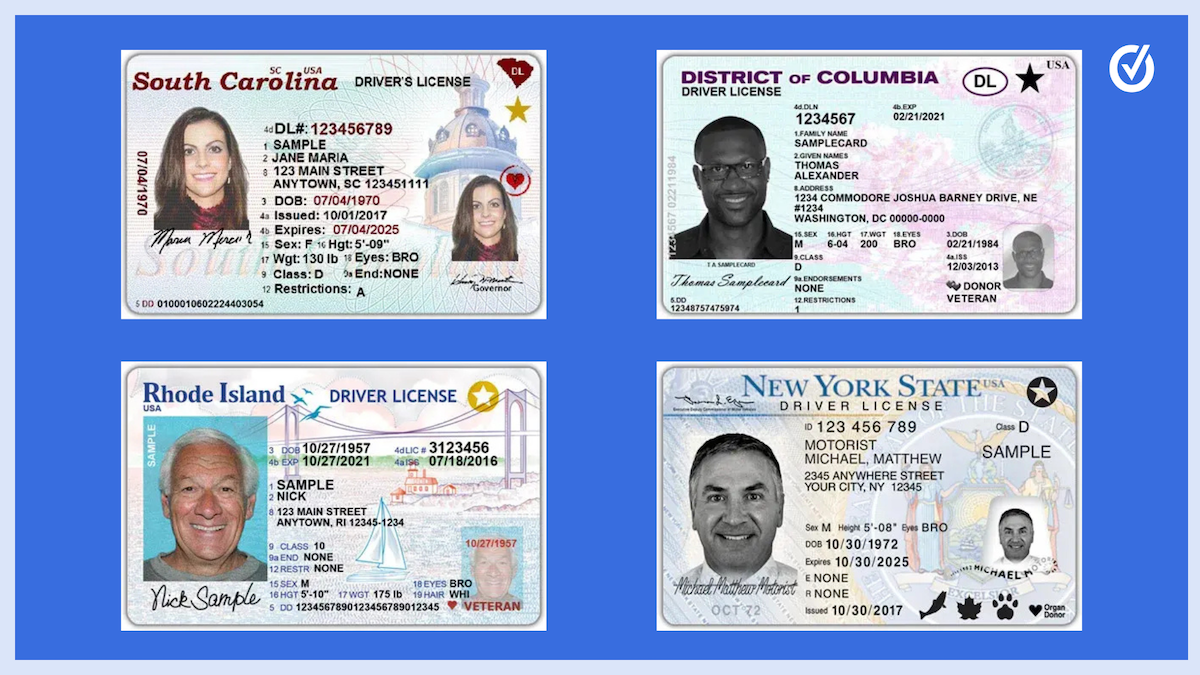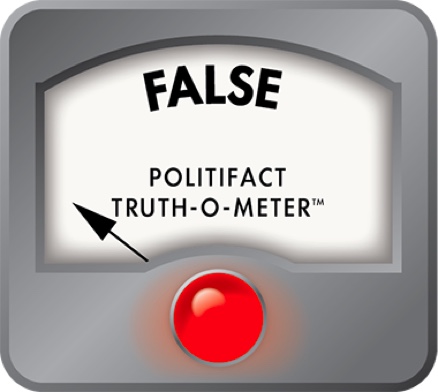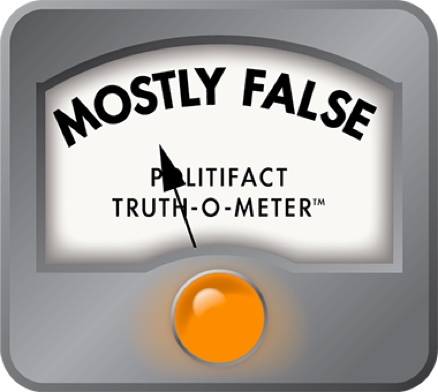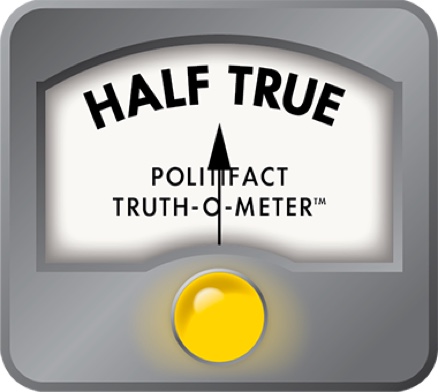Stand up for the facts!
Our only agenda is to publish the truth so you can be an informed participant in democracy.
We need your help.
I would like to contribute
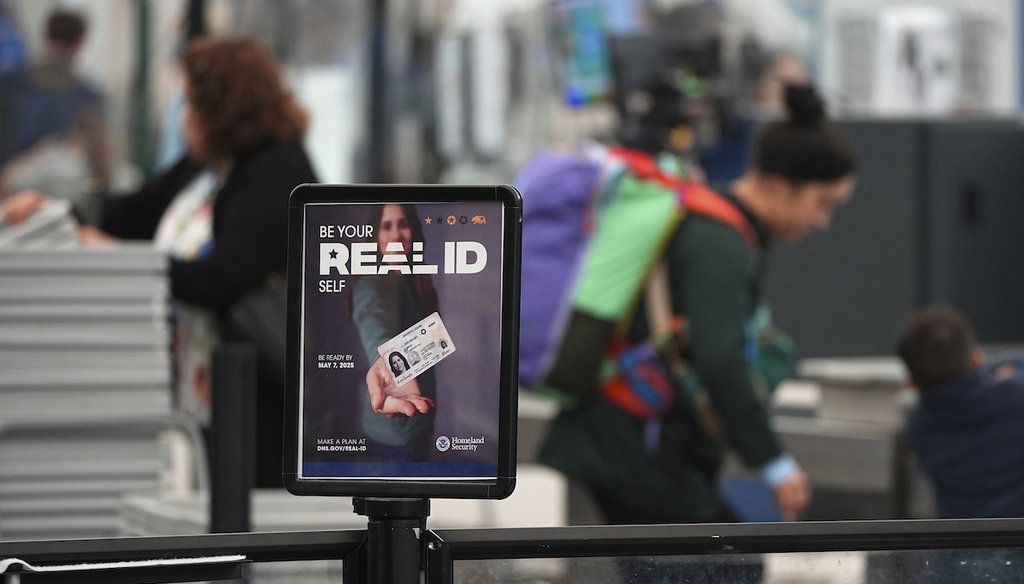
Sign displays need for passengers to produce Real ID documents at the south security checkpoint in Denver International Airport May 7, 2025, in Denver. (AP)
If Your Time is short
-
In a rule that took effect May 7, all U.S. residents 18 and older who are flying domestically are required to have Real ID-compliant documentation.
-
The requirement stems from the 2005 Real ID Act that aimed to raise security standards for state-issued identification cards following the Sept. 11, 2001, terrorist attack.
-
Only people with legal immigration status — including people who are noncitizens in the U.S. on green cards or student visas, for example — are eligible to receive Real ID cards. But other types of documentation such as passports, foreign and U.S.-issued, also comply with the Real ID law’s requirements.
Many people across the nation are clamoring to replace their driver’s license and state IDs with the Real ID-compliant cards now required for U.S. domestic flights.
As of May 7, all U.S. citizens over 18 must show proof of identification that meets the 2005 Real ID Act’s rules. But this change in federal travel requirements is creating some confusion about what it means for noncitizens.
Passed two decades ago by Congress in response to the bipartisan 9/11 Commission's recommendations following the Sept. 11, 2001, terrorist attacks in New York, Pennsylvania and Washington, D.C., the aim of the program was to raise security standards for domestic travel and federal and nuclear facility access.
But immigration experts say the law’s enactment during the second Trump administration has left noncitizens — including some of the 13.5 million people legally in the U.S. on green cards, work and student visas and humanitarian parole — uncertain about what the rule change could mean for their own travel.
President Donald Trump has promised and prioritized mass deportations of criminals and people illegally in the U.S. But in practice, his policies have swept up U.S. citizens and people with a legal immigration status. He has also tried to end legal pathways that allowed people to temporarily live and work in the U.S. Many of these actions are being challenged in court.
Here are some answers to commonly asked questions about Real ID and its effect on citizen versus noncitizen travel.
What is special about Real ID?
The Department of Homeland Security says the aim of the Real ID requirements was to bring consistency to the minimum documentation requirements needed for state-issued IDs — driver’s license, learner’s permits and nondriver IDs.
Now, all states issuing Real ID-compliant cards require people applying for those cards to present certain documentation. The exact requirements vary by state, but in most cases the minimum documents needed include:
-
Proof of identity in the form of a U.S. birth certificate, U.S. passport, or a green card.
-
Social Security Number in the form of a Social Security card, W-2 form, or a pay stub.
-
Two proofs of address of principal residence, which may be a utility bill, bank statement or mortgage statement.
-
Lawful status proof, including a valid employment authorization document, Social Security Number or a valid unexpired visa.
A Real ID card bears a black or gold star or a U.S. flag in its upper right corner. State-issued ID cards that don’t have these markers will not be accepted as proof of identity to board domestic flights or enter federal facilities.
Here are some examples of what Real IDs look like:
Examples of Real ID-compliant driver’s licenses posted on the Department of Homeland Security’s website.
If I don’t have a Real ID, does it mean I cannot travel domestically anymore?
No, you can still travel domestically provided you have another form of identification that is Real ID-compliant.
The Transportation Security Administration lists many other forms of acceptable IDs, including options for people who are not U.S. citizens. Among them:
-
State-issued enhanced driver's licenses or enhanced IDs, which provide proof of identity when crossing the U.S. borders in a vehicle.
-
Foreign government-issued passports.
-
Department of Homeland Security trusted traveler cards under programs such as Global Entry, which let U.S. citizens, green card holders and some foreign nationals to go through expedited lanes at airports.
-
U.S. Department of Defense IDs, including IDs issued to dependents of people in the military.
-
Lawful permanent resident cards, also known as green cards.
-
Border crossing cards, a document used by Mexican citizens to enter the U.S.
-
Acceptable photo IDs issued by federally recognized tribal nations, including enhanced tribal cards.
-
HSPD-12 PIV cards, which are used by federal contractors to access facilities and systems.
-
Canadian provincial driver's license or Indian and Northern Affairs Canada cards.
-
Transportation Worker Identification Credentials (TWIC).
-
U.S. Citizenship and Immigration Services Employment Authorization Cards.
-
U.S. Merchant Mariner Credentials, which show evidence of a mariner’s qualifications; and
-
Veteran Health Identification Cards (VHIC).
There’s one big caveat: TSA says the list of acceptable IDs is subject to change without notice and advises travelers to check the list before traveling.
How could Real ID affect noncitizens as they travel in the U.S.?
Although numerous forms of ID are accepted for noncitizens, the Real ID policy could have a chilling effect on travelers whose documentation differentiates them from citizens, immigration experts told us.
As one example, immigration attorney Prerna Lal said that, in any interaction with federal authorities, carrying a foreign passport could lead to scrutiny of that person’s identity if they lack legal immigration status.
"Even with valid foreign passports, undocumented individuals and mixed-status families may avoid traveling due to concerns about interactions with TSA or law enforcement, despite passports remaining acceptable documentation," Lal said. "This fear of enforcement, rather than access to IDs, is the primary chilling effect on the immigrant community."
What happens if people don’t have an acceptable ID at the airport?
A TSA officer may ask a person to complete an identity verification process. If the identity is confirmed, that person will be allowed to enter the screening checkpoint.
Can an immigrant with temporary status obtain a Real ID?
Yes, the Real ID regulations define an individual in a "temporary lawful status" as a person who has a pending application for asylum; has a pending or approved application for temporary protected status; has approved deferred action; or has a pending application for lawful permanent resident or conditional permanent resident status.
The Real ID Act lets states issue temporary, Real ID driver licenses and ID cards to people with temporary status. People with a temporary immigration status are usually granted temporary valid employment authorization and Social Security numbers, which they can use to apply for Real IDs. Their temporary Real ID will remain valid until their lawful status expires. Florida is one exception: The Sunshine State requires almost all immigrants with lawful status to renew their IDs annually. Green card holders in Florida don’t have to renew a REAL ID every year; their Real ID is valid until their green card expires. Most green cards are valid for 10 years, but people can apply for a renewal.
Also, people with valid student or work visas can present their unexpired passports, visas and I-94 form, a document that shows a person’s authorized period of stay in the U.S., for proof of identity and legal status and get a Real ID.
States that provide non-Real ID compliant ID cards to people without legal immigration status can still do so, according to DHS, but the cards must clearly state that they are not acceptable for Real ID purposes and must have a unique design or color to differentiate them from compliant cards. These non-Real ID compliant ID cards cannot be used as a form of identification for domestic travel.
Could a Real ID prevent an arrest by immigration authorities? Does it confirm that a person is legally in the U.S.?
Lal told PolitiFact that a Real ID alone does not prevent a U.S. Immigration and Customs Enforcement’s arrest or confirm a lawful immigration status. Although Real ID-compliant identification requires proof of lawful presence for issuance, it is not proof of current immigration status.
"ICE conducts its own verification, and possessing a Real ID does not grant immunity from enforcement actions," Lal said.
Lal said that people should present to ICE valid, government-issued documentation that shows their current immigration status, such as a green card, employment authorization card or visa.
Our Sources
Phone interview with Ediberto Roman, professor of law & director of Immigration and Citizenship Initiatives at the Florida International University, May 8, 2025
Email interview with Jasleen Singh, counsel in the Brennan Center's voting rights program, May 8, 2025
Email interview with Immigration attorney Prerna Lal, May 8, 2025
USA.gov, How to get a Real ID and use it for travel, updated April 14, 2025
USA.gov, State motor vehicle services, accessed May 8, 2025
DHS, Real ID Frequently Asked Questions, accessed May 8, 2025
TSA, Acceptable Identification at the TSA Checkpoint, accessed May 8, 2025
FindLaw, What Is a Real ID, and Do I Need It to vote?, Feb. 14, 2024
VoteRiders, What is Real ID?, accessed May 8, 2025
NCSL, Voter ID Laws, updated April 16, 2025
News4Jax, Florida enacts stricter driver’s license rules for legal immigrants, May 5, 2025
Federal Registry, Indian Entities Recognized by and Eligible To Receive Services From the United States Bureau of Indian Affairs, accessed May 8, 2025
Travel.State.Gov, Get a Passport Card, accessed May 8, 2025
Travel.State.Gov, U.S. Passports and Real ID, accessed May 8, 2025
TSA, Real ID, accessed May 8, 2025
USA.Gov, Who can and cannot vote, accessed May 8, 2025
USCIS, How do I renew or replace my permanent resident card?, accessed May 12, 2025
GSA, Federal credentialing services, accessed May 12, 2025
Maritime Institute, GET MERCHANT MARINER CREDENTIAL (MMC), accessed May 12, 2025
DHS, Enhanced Drivers Licenses: What Are They?, accessed May 12, 2025
Pew Research Center, What the data says about immigrants in the U.S., Sept. 27, 2024
PolitiFact, Can Donald Trump use a 1798 law to carry out mass deportations?, Oct. 18, 2024
PolitiFact, Ask PolitiFact: What evidence does the government need to deport green card, visa holders?, March 26, 2025
The Washington Post, Here are the U.S. citizens caught in Trump’s immigration crackdown, updated May 3, 2025
PolitiFact, How spin and falsehoods propelled Trump's immigration crackdown in his first 100 days, April 28, 2025

